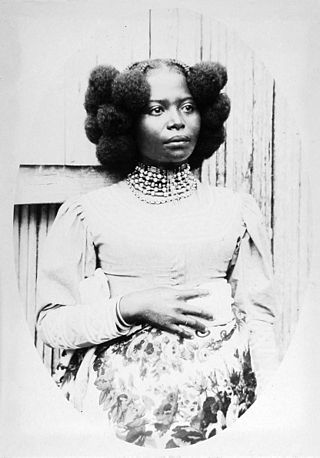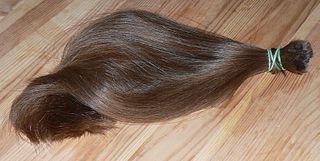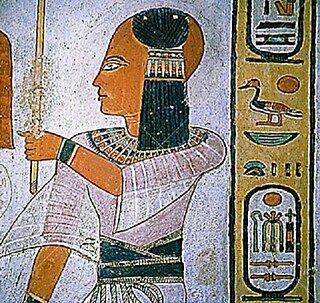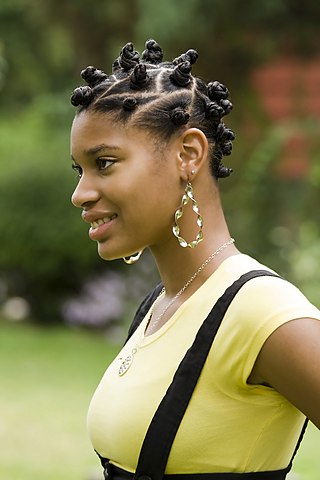
A hairstyle, hairdo, haircut, or coiffure refers to the styling of hair, usually on the human head but sometimes on the face or body. The fashioning of hair can be considered an aspect of personal grooming, fashion, and cosmetics, although practical, cultural, and popular considerations also influence some hairstyles.

Dreadlocks, also known as dreads or locs, are a hairstyle made of rope-like strands of hair. This is done by not combing the hair and allowing it to mat naturally or by twisting it manually. Over time, the hair will form tight braids or ringlets.

The afro is a hair style created by combing out natural growth of afro-textured hair, or specifically styled with chemical curling products by individuals with naturally curly or straight hair. The hairstyle can be created by combing the hair away from the scalp, dispersing a distinctive curl pattern, and forming the hair into a rounded shape, much like a cloud or puff ball.

Cornrows are a style of traditionally three-strand braids, originating in Africa, in which the hair is braided very close to the scalp, using an underhand, upward motion to make a continuous, raised row. Cornrows are often done in simple, straight lines, as the term implies, but they can also be styled in elaborate geometric or curvilinear designs. They are distinct from, but may resemble, box braids, Dutch braids, melon coiffures, and other forms of plaited hair, and are typically tighter than braids used in other cultures.
Artificial hair integrations, more commonly known as hair extensions, hair weaves, and fake hair add length and fullness to human hair. Hair extensions are usually clipped, glued, or sewn on natural hair by incorporating additional human or synthetic hair. These methods include tape-in extensions, clip-in or clip-on extensions, micro/nano rings, fusion method, weaving method, and wigs.

The conk was a hairstyle popular among African-American men from the 1920s up to the early-to-mid 1960s. This hairstyle called for a man with naturally "kinky" hair to have it chemically straightened using a relaxer called congolene, an initially homemade hair straightener gel made from the extremely corrosive chemical lye which was often mixed with eggs and potatoes. The applier had to wear gloves and the solution timed just right on the applicant's head and then thoroughly rinsed out with cold water to avoid chemical burns. The desired outcome was for the newly straightened hair to be easily styled in the popular "conk" style of that era.
Dread perming is a chemical treatment that is used both by beauty salons and do-it-yourselfers to create or maintain dreadlocks. The hair is exposed to chemicals that render the hair frizzy. The frizzy hair is bound together and treated again to form the dreadlocks.

Kinky hair, also known as nappy hair or afro-textured hair, is a human hair texture prevalent in the indigenous populations of many regions with hot climates, mainly sub-Saharan Africa, some areas of Melanesia, and Australia. Each strand of this hair type grows in a repeating pattern of small contiguous kinks which can be classified as tight twists and sharp folds. These numerous kinks make kinky hair appear denser than straight, wavy, and other curly hair types.

Synthetic dreads, also called dread extensions, dread falls, and cyberlocks, are interlocked coils of synthetic hair, mostly kanekalon, that give the look and feel of natural dreadlocks without the commitment or maintenance. They are mainly worn as a fashion statement for the subculture of cybergoth.

African-American hair or Black hair refers to hair types, textures, and styles that are linked to African-American culture, often drawing inspiration from African hair culture. It plays a major role in the identity and politics of Black culture in the United States and across the diaspora. African-American hair often has a kinky hairy texture, appearing tightly coiled and packed. Black hair has a complex history, culture, and cultural impact, including its relationship with racism.
Discrimination based on hair texture, also known as textureism, is a form of social injustice, where afro-textured hair or coarse hair types, and their associated hair styles, are viewed negatively, often perceived as "unprofessional", "unattractive", or "unclean". This view can lead, for example, to some school students being excluded from class.

Hair theft has been a recurrent problem in various parts of the world where human hair is in demand, either for commercial products such as wigs and hairpieces, or for sexual fetishes. As hair has a high commercial value – in the mid-19th century it was regarded as worth twice its weight in silver – opportunist thieves have targeted long-haired women, and less commonly men and children, with the aim of stealing their hair. Hair thieves have typically sought either to surreptitiously cut off hair in public places, or have mugged people and shorn their heads. The crime of hair theft has been widely reported in North America, Europe, Asia, and Australasia over the course of at least 300 years.
The natural hair movement is a movement which aims to encourage people of African descent to embrace their natural, afro-textured hair; especially in the workplace. It originated in the United States during the 1960s, and resurged in popularity in the 2000s.

Box braids are a type of hair-braiding style that is predominantly popular among African people and the African diaspora. This type of hairstyle is a "protective style" and is "boxy", consisting of square-shaped hair divisions. Box braids are generally installed by using synthetic hair which helps to add thickness as well as helping the natural hair that is in the braid. Because they are not attached to the scalp like other similar styles such as cornrows, box braids can be styled in a number of different ways. The installation process of box braids can be lengthy, but once installed they can last for six to eight weeks. They are known for being easy to maintain.

Braids are a complex hairstyle formed by interlacing three or more strands of hair. Braiding has been used to style and ornament human and animal hair for thousands of years in various cultures around the world.
In the United States, discrimination based on hair texture is a form of social injustice that has been predominantly experienced by African Americans and predates the founding of the country.
Wicks are a hairstyle originating in South Florida by Haitians. This hairstyle is prevalent amongst African-Americans. The hairstyle originated from Afro-Caribbean people involved in the Hip-Hop community as well as related subgenres in Florida.

A protective hairstyle is a term predominantly used to describe hairstyles suitable for Afro-textured hair. These hairstyles are designed to minimize manipulation and exposure of the hair to environmental elements. Factors such as extreme temperatures, humidity, and precipitation can adversely affect hair health. Protective hairstyles are beneficial in mitigating these effects by keeping the hair tucked away and reducing its exposure to potentially damaging conditions.

Rogers v. American Airlines was a 1981 legal case decided by the United States District Court for the Southern District of New York involving plaintiff Renee Rogers, a Black woman who brought charges against her employer, American Airlines, for both sex and race discrimination after she was dissuaded from wearing her hair in cornrows due to the airline's employee grooming policy. Rogers believed that this hair policy was a violation of her Title VII rights.

The Creating a Respectful and Open World for Natural Hair Act of 2022 was a bill in the United States Congress intended to prohibit discrimination based on an individual's hair texture or hairstyle by classifying such discrimination illegal under federal law. It applied to federally assisted programs, housing programs, public accommodations, and employment. The act was introduced in the House of Representatives by Congresswoman Bonnie Watson Coleman (D-NJ) on March 19, 2021. Senator Cory Booker (D-NJ) introduced a companion bill in the Senate on March 22, 2021. The CROWN Act of 2022 marked the second time the legislation was introduced in Congress.














